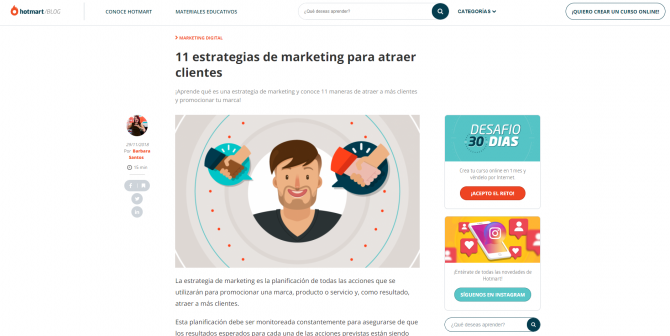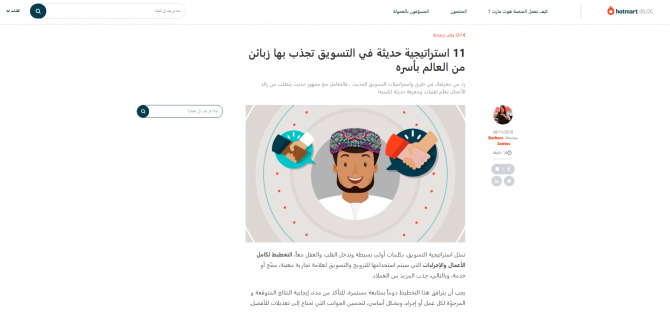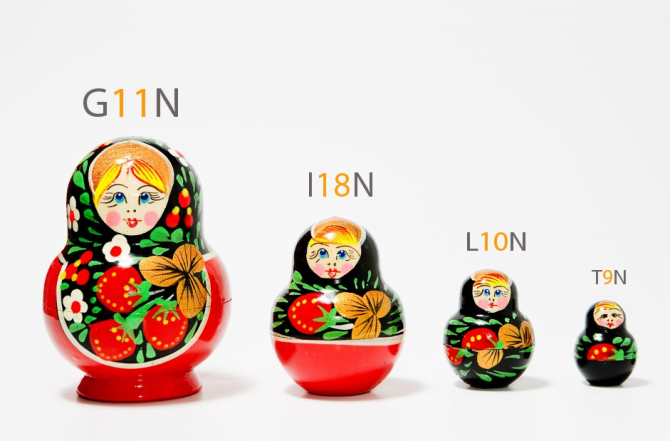
Don’t Just Translate, Localize: How to Sell your Online Product around the World
Learn about content localization and sell across borders with no boundaries by speaking to potential buyers anywhere in the world.

What will we see in this post
Hi, I’m Adriano, Localization Manager at Hotmart. Our team’s content localization work is very simple:
We provide linguistic and cultural solutions for our products, ensuring assertive communication when adapting and creating content to build trust with people worldwide.
In other words, what localizers do goes far beyond just translating content, whether it’s a blog post, the platform’s buttons, our usage policies, or website. They immerse themselves in the culture of those who will read it, adapting and recreating texts, images, examples, ways to communicate, and even the CTAs.
In short, we modify and adjust the content so that, in addition to being linguistically appropriate, it will fit the culture and values of the country or region of those reading.
For starters, do I really need to localize my content?
You’ll see that the answer to this question is obvious, but let’s take a look at two examples before answering it.
Let’s say you have a digital product with copywriting in British English, by you, who are British. You have targeted your audience in England for years, but now you want to start selling more in other countries where English is the de facto language.
The language is the same, right? So, to sell beyond the 66 million inhabitants in the UK, all you have to do is create sales pages for these other countries, pay the mandatory taxes, and start spreading the word, right?
Well… wrong.
Despite the fact that some common standards of the language follow the same rules, all these “versions” of English have variations in vocabulary, spelling, expressions, and many other details that only those who are reading content written by a native speaker of the specific country can identify.
And if you can find so many variants of spoken English in the UK alone, imagine all the different English-speaking countries spread around the world!
Think about someone from a non-English-speaking country who wants to sell in English.
Most people think that all they have to do is translate something into English and everyone will understand and be interested in the content. But no, this is another common mistake.
Although English is the “official” commercial language, and many people speak it around the world, only 20% of the global population speaks English. In other words, 6 billion people don’t speak the so-called “universal language”.
Oh, and here we have an important detail: despite being the “most famous” language in the world, English is ranked third among the most spoken languages on the planet. The first is Mandarin, and you may have already guessed the second one: Spanish! But let’s get back to English, which despite these details, is an important one.
There are so many cultural differences among English-speaking countries that sometimes something that should be a pleasure to read becomes difficult, tedious, and people just give up trying.
Not to mention that people prefer to shop and read content in their own languages. And we have studies to prove it!
According to a Common Sense Advisory survey with over 3,000 global consumers from countries that do not speak English as a first language, 75% prefer to buy products in their native language. Plus, 60% never or rarely buy from sites that exist only in English.
Another important study shows that in the United States alone, over $40 billion was spent on translation and interpretation services in 2016 alone.
Now, answering our initial question has become much easier, right?
When you sell your digital product in other countries, content localization isn’t merely an option; it’s a necessity.
Even if it only means changing the spelling of certain words in a text, removing expressions, or changing measurement units, dates, and currencies used, localizing your content is a requirement for any company that wants to overcome borders.
Here at Hotmart, the Localization team works for two customers:
- The first group is formed by our coworkers who produce the original content (be it in Portuguese, Spanish, or English).
- The second is our end-user, who will have access to the content already translated and localized.
Our priority is always the end customer, who will have access to the content as if it had been produced in the language they are reading or watching.
Let me show you a simple example from the Hotmart blog. This is an article about marketing strategies to attract customers.
Take a look at how it looks when the text is in Portuguese:

And this is the same content localized for the English-speaking world:

Now, take a look at what it looks like in the version for the Arab world:

You don’t even need to know what’s written to understand that it was a process that involved much more than simply translating words, right?
The position of the buttons, reading from right to left, and the image all changed. Not to mention the changes to the content, with different examples and subtle cultural adaptations for people who read Arabic and grew up with different pain points, values, and purchasing expectations.
That’s why we’re talking about content localization, so you can sell your product around the world!
Why do I need to learn about localization?
The answer is simple. Nowadays, you don’t need to be in a physical classroom to teach what you know.
With online courses, you can have thousands of students in different states and cities, taking your classes at any time of the day or night, answering questions by email or Telegram, and receiving a certificate upon completion.
Well, but you already knew this, and that’s why you have a digital product.
And if you can do it for an entire country, why not do it for other markets beyond your borders?
That’s where localization comes in.
What we’re going to see today is how to go about localizing content. How to contract freelancers or companies that will do the job with the quality that your product deserves. And how to have quality control over the work that’s been done.
1. Localization vs. Translation
Many people confuse localization with translation.
First, let’s talk about translation. This is the simplest, most basic concept we have here, and it’s exactly what you’re thinking. Converting written text from one language to another.
Nowadays, there are lots of apps that translate text automatically. But they don’t always work the way we’d like. We’ve all come across something and thought to ourselves, “Hmm, this was Google-translated.”
Sometimes, mistranslation can really hurt a business.
A few examples:
- In the late 1980s, KFC’s famous slogan, “finger-licking good,” was mistakenly translated into Chinese to something like “eat your fingers.” Eventually, they corrected the mistake, and today, KFC is the leading fast-food chain in China.
- In 2009, HSBC bank had to change an entire campaign after 5 years because of mistranslations. The slogan was “Assume nothing,” but in several countries, the translators changed the phrase to “Do nothing.” The bank had to spend more than $10 million to change the entire campaign and its slogan to “The world’s private bank.“
- Occasionally, translation errors turn out to be a great opportunity. In the Street Fighter videogame, the translation from Japanese to English ended up creating a new character. One of the character’s lines mentioned the name of a special move but was translated as the name of a person. The sentence ended up like this: “You must defeat Sheng Long to stand a chance.” Players went crazy trying to find this fighter, Sheng Long, in the game. In 1992, a magazine even published a series of difficult instructions to find the fighter, but it was just an April Fool’s prank.
Nowadays, good translators work with all kinds of tools, and not only the good old dictionaries. There are translation memory databases, different programs that help translators find the best matches, and CAT Tools (CAT – Computer-aided Translation), which combine the best of both whttps://miro.com/app/board/uXjVN0anAY0=/orlds: algorithms and human experience.
In short, translators have a bunch of tools with different interfaces at their disposal, to help them in their work.
One day, perhaps, all translation work will be done by computers. But I would venture to say that this day is still a long way off.
If it’s hard to find a program that does excellent machine translations, finding a program to do localization will be practically impossible. Localization goes far beyond translating. Translations focus much more on the linguistic part, while localization works with the cultural part in a much more comprehensive way.
While translating is about language and how to contextualize what is being said from one language into another, localization goes beyond that.
The content needs to be characterized for the localization so that the person who is being impacted feels as if a fellow citizen has produced the text, created the image, or recorded the video.
As shown in the Hotmart blog example, localization is about making content enjoyable, fluid, and with references that the reader can relate to. In short, localization focuses on empathy.
This happens, for example, with brand names that have outgrown their original meaning and have taken on the status of popular sayings, which are comparisons we make all the time.
Imagine translating Budweiser’s “Wassup?” or Lay’s “Betcha can’t just eat one” into another language in a country where those brands aren’t as popular. It won’t work if we can’t find other brands and institutions in the target language that the reader will relate with.
Big brands also use localization to create effective campaigns worldwide.
Everyone remembers Coca-Cola’s “Share a Coke” campaign, right?
Just imagine if the names on the cans in the rest of the world were the same as in the United States, such as Mary, John, or Tom? Of course, they used names that were common locally.
In China, where it isn’t common to refer to someone by their first name, they even switched to terms like “best friend” or “classmate.” This way, they were able to achieve their goal of eliciting personal connections with the buyers.
One company that’s great in terms of localization is Pixar. The movie “Inside Out,” for example, was a worldwide success, and we can find several examples of localization that were extremely well done.
The movie’s director, Peter Docter, said that he realized that if the movie were played the same way in every country in the world, many things wouldn’t have made sense.
In the scene where a child refuses to eat vegetables, for example, in the American version the child thinks the broccoli her father gives her is disgusting. But in Japan, children love broccoli, and the version shown there replaced the vegetable for bell peppers. It’s subtle, but what an impact it has!

Another scene shows the father daydreaming during dinner. In the original scene, he’s thinking about ice hockey. But of course, this wouldn’t work in many other countries where hockey isn’t played. The solution was to replace it with football, or soccer, which works very well in other markets, don’t you agree?


It’s easy to see that Pixar’s goal was simply to speak, as naturally as possible, to whoever is watching the movie.
That’s what localization does. It puts you in the shoes of the person who is reading the content, watching a video or movie, playing a game, or taking an online course.
And we can find other examples even with simple things that others may think are weird.
Think of all those times when you’ve become annoyed by subtitles or translations that use measurements or currencies that are different from those you know. Effective localization puts an end to these problems.
For online courses and other digital products, localization increases engagement which t goes beyond merely putting out more content.
Localization creates a connection with the user that a mere translation can’t provide this connection. In short, the proposal and the solution of your product need to focus on your persona’s needs, which vary according to the country and culture.
2 – Internationalization vs. Globalization
Many people confuse internationalization with globalization.
First, let’s define what internationalization is in this context.
Internationalization is the process of preparing a product so that it can be adapted for any market. In other words, making the product as generic as possible.
For example, this implies:
- Leaving enough space in your ebook or software for languages that use more characters;
- Including character encoding (everyone has come across broken characters on a website or application);
- Using international time and date standards, so that people don’t get confused;
- Standard currency symbols;
- Reviewing all the content so that there’s nothing specific to a locale, such as colloquialisms, slang, or cultural references.
And why should you internationalize your product?
- In order to spend less on localization;
- To make updates easier (you have a “raw” product that can be modified and then updated in other languages);
- To be culturally independent, without the risk of offending anyone.
Objectively, it’s true that internationalization affects development teams much more than content creators.
However, if the entire chain thinks about internationalization, the product will be ready whenever you need to invest in a new market. This may happen all of a sudden, if your competitor decides to enter a market, for instance.
Now, what about globalization?
Globalization, on the other hand, isn’t considered a process, but a strategy that involves both internationalization and localization. In it, we find the commercial aspects of launching a product in different markets.
To launch a product for the global market, you need to be ready with customer support that can answer user questions in different languages, understand the legal and taxation aspects, and create effective marketing strategies for different locations.
All that to say, the internationalization and localization of your product’s content come before globalization. But that doesn’t prevent you from carrying out an initial survey to give you an idea of all the challenges you might encounter along the way.
To recap:
- The ideal process is to internationalize your content so that it can be localized to anywhere in the world;
- Localize the content, which includes translation, for a specific market, taking into account linguistic and cultural characteristics – from here on, you can enter other markets, test and see what is working, and what needs to be improved;
- And then, globalize your brand, taking your product or service to the world.

Abbreviations for Globalization, Internationalization, Localization, and Translation
The best example I can give you is in South America. Brazil is a huge country, with almost 210 million inhabitants in 8.5 million square kilometers.
In comparison, the 11 other countries in South America have an area of 9.5 million square kilometers and 210 million inhabitants that speak mostly Spanish.
In other words, Portuguese-speaking Brazil is surrounded by Spanish speakers. Although there are a lot of differences between the countries, they have a lot in common.
What if a company in Brazil wants to start selling in the rest of South America? Is only one form of Spanish spoken in South America? Of course not! Each region has its own specific form of language, types of approach, expressions, and even different personal pronouns.
But a comprehensive form of Spanish exists, which can be used initially in order to reach a large number of people in Latin America.
After initial tests using this more internationalized version of Spanish, the numbers will show the specific localization required to be successful in each South American country. And localization will be the solution to everything, as we’ll see in more detail below.
3. How to find the right people to localize your content
Now that your content is ready to be localized and win over the world, you should do some research before contracting the experts who will localize it.
Here, we have two options – you can either contract a translation and localization agency (and there are many, which are global, with a wide range of prices), or freelancers to localize your content.
The first step during this phase is to understand if the content is ready, internationalized (if applicable), translated, and localized.
So, ask yourself:
- Is there only text to be translated?
- Are there tables or charts?
- Are there images with text? (Image files also need to be sent, if this is the case).
- Do we have sources for the data I present in my content? News websites, links to reports, links to statistics, links to videos? (Do these videos, even if they are on YouTube or Vimeo, have subtitles or versions in the target language?)
- And how many words will be translated? This is a decisive question since it’s internationally established that translation companies and freelancers charge per word. So if the content is in PDF form, or if there are pictures with text, it’s harder to reach a precise number, and you should address this before you order the content localization.
All this is part of the content’s internationalization and avoids a lot of rework after the first translations and localizations. In addition, it prevents the company or freelancer from delaying delivery, using the lack of briefing on these details as an excuse (a valid one, to be honest).
And of course, the most important question: in which language and for which market will it be prepared?
Translation agencies or Freelancers?
Once this question has been answered, we return to our topic: agencies or freelancers? Of course, each option has its pros and cons. Let’s take a closer look at them.
When hiring a translation agency, the first question you should ask is, who are the translators that this agency hires (or will hire, depending on the language), and what other services will the agency include in the price. This is important because agencies are usually merely intermediaries.
These agencies, also called LSPs (Language Service Providers) usually work as follows: they receive the brief and pass it on to the translators and localizers who will transform the work.
Some of these agencies are also responsible for quality control, making sure that the work has been performed well.
And this is basically why agency prices are higher than those charged by individual freelancers.
Another advantage of agencies is that they have access to a wider pool of translators, which makes it easier to distribute the work and achieve better delivery times.
Let’s suppose that you have access to an excellent freelancer and, in addition to taking freelance work, they also work with an agency.
If they charge, let’s say, 12 cents per word, the agency will have to charge this amount and add a profit margin as an intermediary. If the price charged by the agency is the same 12 cents, this means that the agency is paying the translator less.
It’s possible that the translator likes working with the agency, has a long relationship with them, and gives them a better price. It’s also possible that the translator needs the work and is settling for less.
In any case, remember that a happy worker produces more and better.
Another characteristic of translation agencies is that they can meet tighter deadlines, precisely because they have access to many translators. But this also means that several people will be working on the same text.
So, if your deadline is really tight, it might be better to contract an agency. But make sure they have a good team that reviews and standardizes the terms, language usage, and even the style that will be used (informal, neutral, or formal).
A good translation agency will know how to choose the best translator for each type of job.
Here’s a tip that applies for both agencies and individual freelancers: social proof.
You need feedback from those who have already worked with these people, how they handled deadlines, whether there was clear communication. And most importantly, the assessment of end consumers, i.e. the people who read or watched the translated and localized content.
There are also advantages to hiring freelancers.
The first, of course, is price. By talking directly to them, you can negotiate deadlines and prices (again, it’s good to ask for references and evaluate the portfolio with jobs already done) and reach an agreement that is good for you and for the translator.
Furthermore, by hiring a freelancer, you have a direct and constant communication channel with them. You can follow up on the work being done, provide guidance with terminology, and understand how your content is being localized.
Of course, this doesn’t always work if you are translating and localizing for multiple languages. In this case, your point of contact for all languages should be centralized. It’s not easy to coordinate 8 or 10 freelancers working for you at the same time, so I recommend that you hire an agency.
Another advantage of hiring a freelancer is that you can hire someone else to proofread the work, and in this case, you’ll have another point of view about not only the work but the content as well. It’s essential that this proofreader be a native speaker of the language into which the project is being translated and localized, which brings us to another point of attention.
It’s important to analyze the freelancer’s resume to find out if they’re the right person to translate your content and if they have experience with the theme or topic you cover in your material.
Does it contain a lot of jargon or technical terms? The more specific the topic you cover, the more specialized the localizer should be and the more detailed the brief should be.
It’s important that we talk about native speakers. Not every native speaker is a translator. Just like not every person who speaks a language very well can be a translator for that language.
To make it clearer, think of language teachers.
For example, an English woman speaks the Queen’s English perfectly, but that doesn’t mean she can teach English. You have to train to become a good teacher, learn how the grammar works and teaching techniques. These are all indispensable for a good English class.
And the same goes for translators. If you want to localize your content from English into Spanish to do business in Spain, who would you choose to translate it: an American translator, a Mexican one, or a Spanish translator who’s lived in the US?
Of course, other factors will have to be taken into account, but you want a translator who knows exactly what your buyer persona wants, how to talk to them, their cultural references, and many other details only a good translator and localizer will know how to identify.
In short, a good rule of thumb is:
- If the volume is high (or if there are many languages) and the deadline is short, contract an agency;
- If the volume isn’t high, and the deadline is flexible, look for freelancers.
A quick search online will give you a large list of LSPs. And websites, such as Fiverr, Upwork, and Workana, will give you access to many freelancers.
And of course, always remember to ask for references and previous work.
4.Quality Control
Now that you know who will translate and localize your content, we need to make sure they did a good job. And we also need to look at certain important details.
But let’s take things one at a time.
The first part of quality control is done by the translation agency (LSP) or the freelancer you contracted. But it’s important that you ask someone local to evaluate the translation work.
Only someone living there, at that moment, or a person who has extensive experience in that place, who studies the language and customs, will have the authority to say if the language is adequate, if the terms used make sense, and if the examples and references that appear in the content were done with those living in that location in mind.
Once again, excellent localization is indistinguishable from work that’s been produced by a person who’s from that specific locale. The localizers need to put themselves in the shoes of the reader or viewer and make everything flow as naturally as possible.
This quality control needs to be performed thoroughly. First, not to offend or harm anyone, and second, to stand out in that market and make more sales.
Now let’s talk about a few details that cannot be neglected in your localization strategy:
Time zone
One very simple thing that we sometimes overlook is Customer Support hours.
Businesses often want their response time to buyers to be as fast as possible, but this isn’t always the best thing to do.
A well-rounded response that really takes the buyer’s question or complaint into consideration is much better than merely sending a canned message in a rush just to beat reply time targets.
This is an important part of localization. Usually, the customer support of an online entrepreneur who is selling to other countries doesn’t take into account that the buyer might receive a message at 3:30 a.m. because of the local time zone.
When that person wakes up, goes to work, and sees a bunch of messages in their inbox, will your customer support reply stand out?
That’s why it’s important that your customer support takes into account the buyer’s time zone, understands the best time for them to receive an email, and then sends the reply. And this goes for your entire email funnel strategy.
Payment methods
Another important detail is the payment method.
When you enter other markets, it’s important to understand what payment methods people use. Credit cards, debit cards, bank transfers, PayPal, etc.
These are just a few, there are thousands of different ways to pay, and you have to understand what your potential consumers use and expect to find when they arrive on your checkout page.
How can the person pay? Only with a single payment? What about installments? Is interest charged or not?
You have to think about all of these points and understand what’s common in that market.
A good digital product distribution platform thinks about all of these details, studies all possibilities, and provides not only the price in the buyer’s local currency but also the most common payment methods used locally. This way, consumers will feel at ease when completing their purchases.
Pricing
And not only payment methods need to be localized. Price is also a critical point.
Let’s check out a well-known example: the price of a Big Mac.
The most famous sandwich in the entire universe does not cost the same around the world. If you buy $50 worth of Big Macs and use the same $50 converted into Japanese Yen, you won’t get the same number of hamburgers.
Why? For many reasons, including taxes, production costs, transportation, and others. But perhaps the most important is a marketing strategy.
With digital products, you have to think about your buyer persona.
Simply converting your product’s original price might not be a good idea.
Many SaaS (software as a service) companies do this so they have a single price worldwide. Most of the time, the price is centralized in dollars or euros. But if we think about the European Union, we can see how this might be a problem. Although the currency is the same in many countries, the cost of living is very different.
If we dig even deeper, we’ll find that the cost of living differs greatly even when comparing cities in the same country.
But not all companies do this. Spotify a great example.
The monthly fee in the United States is $9.99, or € 8.52. But that’s not the price charged in every country around the world.
In fact, they analyze each market and find a specific price that matches the purchasing power of that country, as you can see in the image below:

Affiliates
Who better to help you with all of these localization issues (which go beyond translating and adapting the content of your material itself) than a good Affiliate?
What are the characteristics of good Affiliates?
- First of all, they understand the niche, or niches, in which they operate, so they know their personas well, their pains and desires, which can help a lot in localizing your content, pricing, and choosing the best advertising channels.
- They understand a lot about the psychology and mental triggers that work for locals, so they know what can motivate people to click on your CTAs.
- They know how to create a sales page that converts, that speaks to local buyers.
- They know how to buy traffic, optimize campaigns, and analyze the business’ numbers and metrics, as well as know the best times for each action that needs to be taken. Great Affiliates know how to make decisions based on technical knowledge and the numbers.
In short, having an Affiliate as a partner in your target country, someone who knows the market and, better yet, knows the people, is a great strategy to localize your digital product.
5. Conclusion
Whew!
If you’ve made it this far, you’ve really learned a lot about content localization.
Are you ready to start this journey? I’ve got a feeling that after your product takes off, it will soar around the globe.
The most important thing, after everything we’ve talked about above, is that you understand who your buyer persona is.
You need to map all their characteristics carefully and offer a product that not only speaks the same language as your persona, but you understand the context in which they live, how they consume content, and what will really add value to their lives.
Still don’t know who your audience is? Check out some tips and learn how to create your marketing persona.





